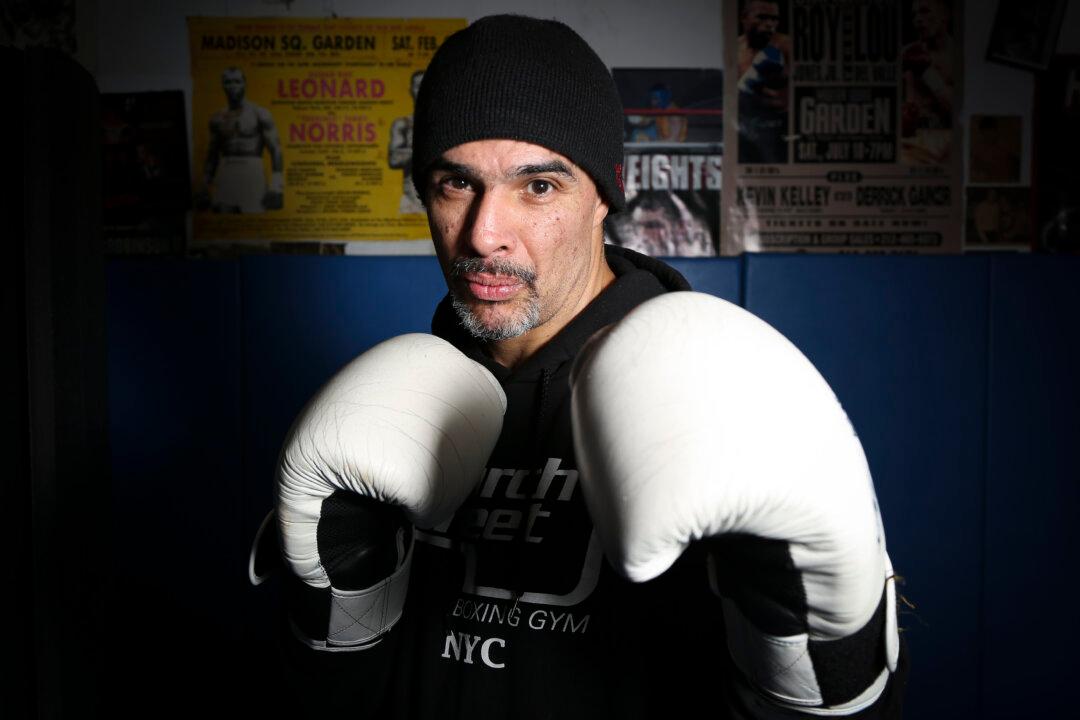NEW YORK—Walk down two floors under Park Place in lower Manhattan, and you enter a gym that’s as real as they come.
The concrete walls of Church Street Boxing gym are covered with posters and newspaper articles mostly about athletes who have trained there. Punching bags of different shapes and sizes dangle from 20-foot-high ceilings, and the centerpiece is a full-size boxing ring. Other workout equipment includes barbells, kettlebells, a climbing rope, heavy-gauge chains, and giant tractor tires.
But the gym is not just for fighters. It attracts people of all ages and from all walks of life from 7-year-olds, to financial-sector and blue-collar workers, and a lot more women than you might expect.
Farah, a social worker who takes several other fitness classes at different facilities, said she keeps coming back to Church Street Boxing for the community.
“I like the people that I work out with because everybody’s serious about working out. It’s not wishy-washy,” she said, adding that they all give it their best. “But it’s also fun. We have a lot of fun together. We egg each other on,” she said.
“It’s a real fight gym, but it’s unique because the everyday person—the women—they feel welcome here. They don’t feel threatened. They get a hard-core workout. They feel like they’re getting the real thing, but they don’t feel threatened,” said co-owner and senior trainer Jenaro Diaz.
According to Diaz, in some classes they have a standing challenge that people can earn a free personal training session if they climb a rope to the ceiling during circuit exercises. When someone tries, the whole class stops and hoots and hollers encouragement.
Fight of Life
The core of the programs are boxing, kickboxing, and martial arts, but they also offer yoga and boot-camp classes.
Diaz also opened a regular class for kids as young as 7 who want to learn boxing—and the self discipline that accompanies fighting.
For Diaz, the boxing and martial arts are about self-empowerment.
“We like to think of this as a place that prepares you for the fight of life. Everybody has their own fight.”
He speaks from personal experience, having come from a boxing family. His father and brother boxed, and his uncle Jose “Chegui” Torres won the world light-heavyweight championship in 1965. Diaz grew up tagging along after them and said he has learned who he is by facing others in the ring.
“Boxing showed me a lot of truths about myself, some that I liked, some that I didn’t like,” he said.
And what you do when you learn these truths can be a game-changer.
“Then you have to make a decision. If this is your truth, are you going to deal with it if it is a negative truth and make it positive? And if it’s a positive truth, are you going to maintain that?”
Diaz recently started a mentoring program for young people who want to learn boxing and are willing to work for it. In exchange for chores at the gym—and provided they “show a better part of themselves”—young people receive fight training and life-coaching.
“We show them how to box correctly. We show them how to study correctly. We show them how to look for work correctly. We show them what is expected at work. We try to make boxing the metaphor of life,” Diaz said.
The gym requires young people to sign an ethics contract stating they will not fight as a way to resolve issues. They must also agree to abstain from drugs and maintain a B-minus average if they are still in school.
Boot Camp
At a recent boot-camp class, Diaz transformed from an affable, reflective mentor into a drill sergeant prepping recruits to survive by the strength of their own arms, legs, and abs.
The class was great cardio and strength training with nearly non-stop motion as Diaz barked orders and encouraged students to push a little more—to complete the lap of bear crawls or punch-kick the pads we were holding a little harder. (And I did end up punching faster and harder than I thought I would be able to).
Other activities included booking it up the stairs to street level wearing the heavy-gauge chain around your neck and lifting and flipping over a giant tractor tire—which, odd as it sounds, gave me a great feeling of accomplishment.
Ellen, who works in the financial sector, has been taking classes from Diaz for 15 years—despite not liking the first class she took from him because she felt too out of breath. The friend she was taking the class with convinced her to come back.
“He makes us laugh while we’re hitting him,” Ellen said of Diaz. “He just has so much high energy. He has patience, and he just makes it fun.”
Another classmate summed it up: “Good abuse,” she said, laughing.
Church Street Boxing Gym
25 Park Place, Manhattan
212-571-1333
NYBoxingGym.com
Five Famous Fighters You Could Have Run into at Church Street Boxing Gym
1. Mike Tyson: b. 1966, Brooklyn, New York. The youngest heavyweight boxing world champion in 1986, also won 1987, 1989, 1990.
2. Evander Holyfield: b. 1962, Atmore, Alabama. Five-time heavyweight boxing champion: 1990, 1993, 1996, 2000, 2010.
3. Joey Gamache: b. 1966 Bath, Maine. Super featherweight champion in 1991. Lightweight champion in 1992.
4. Felix Trinidad: b. 1973 Cupey Alto, Puerto Rico. Welterweight champion 2000, light middleweight champion, 2000–2001; middleweight champion in 2001.
5. Leslie Stewart: b. 1961 Laventille, Trinidad and Tobago. Light heavyweight champion in 1987.
QUIZ: Traditional Disciplines
1. Which form was developed by Samurai warriors?
a. Yoga
b. Jiu-jitsu
c. Muay-Thai
2. Which of the traditional forms below is part of the origin of the sport we know now as kickboxing?
a. Yoga
b. Jiu-jitsu
c. Muay-Thai
3. Which form originated as a way to attain enlightenment?
a. Yoga
b. Jiu-jitsu
c. Muay-Thai
Answers
1) b. Jiu-jitsu. The precise origins of jiu-jitsu are unknown, but the form of hand-to-hand combat was refined and developed by Samurai warriors between the 8th and 16th centuries until guns changed the face of warfare. Jiu-jitsu includes grappling and ground-fighting techniques and is often practiced as a means to learn self-defense.
2) c. Muay Thai. Also known as Thai boxing, Muay Thai is one of the martial arts forms that kickboxing draws on. Fighters use their fists, elbows, knees, shins, and feet—but never their head—to attack opponents. It is Thailand’s national sport and was traditionally performed to music and preceded by a ceremony to honor the fighter’s coaches and the Muay Thai guardian spirit.
Source: Encyclopaedia Britannica
3) a. Yoga. Yoga is an Indian philosophy and practice that aims to help the practitioner enter a state of deep concentration and bliss. Hatha yoga is the form most typically practiced in the West and is popular for it’s ability to help people develop strength and flexibility.
Source: Encyclopaedia Britannica






